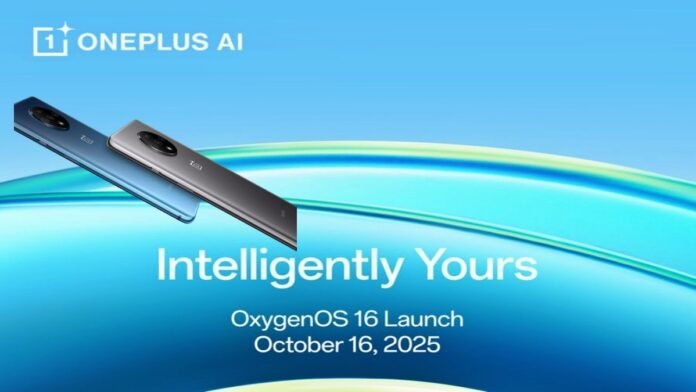
Key Points:
- OnePlus officially announces OxygenOS 16 based on Android 16 launch on October 16, 2025
- New “OnePlus AI” branding revealed with tagline “Intelligently Yours” emphasizing artificial intelligence integration
- Google’s Gemini AI Assistant integration with dedicated AI hub called “Mind Space” for smart information management
- Mind Space allows users to save schedules, tickets, reservations using Plus key or three-finger swipe gesture
- AI automatically categorizes, analyzes, and converts saved information into actionable data like calendar entries
- Full-screen Always-On Display (AOD) feature to show more information without unlocking device
- Major design refresh inspired by OPPO ColorOS 16 with glass-like transparency and layered visual effects
- Visual aesthetics similar to Apple iOS 26 Liquid Glass design language
- Mind Space first introduced in OnePlus 13s smartphone as part of AI Plus Mind Suite
OnePlus has officially confirmed the launch date for its highly anticipated OxygenOS 16 update, revealing that the Android 16-based operating system will debut on October 16, 2025. The announcement, made through the company’s official X (formerly Twitter) handle in India, signals a significant shift toward artificial intelligence-powered features with the introduction of new “OnePlus AI” branding and the compelling tagline “Intelligently Yours.”
AI Takes Center Stage
The teaser released by OnePlus prominently features the new “OnePlus AI” logo, making it abundantly clear that artificial intelligence will be the cornerstone of this major software update. This strategic emphasis on AI reflects the broader industry trend where smartphone manufacturers are racing to integrate advanced machine learning capabilities into their operating systems to enhance user experience and productivity.
OxygenOS 16 represents OnePlus’ most ambitious attempt yet to position itself as a leader in AI-powered smartphone experiences, moving beyond conventional software optimizations to deliver genuinely intelligent features that anticipate user needs and automate routine tasks.
Gemini AI Integration and Mind Space Hub
One of the standout features of OxygenOS 16 is the deep integration of Google’s Gemini AI Assistant, which will work in tandem with OnePlus’ proprietary AI hub called “Mind Space.” This collaboration between OnePlus and Google represents a significant step in making AI assistants more contextually aware and practically useful in everyday scenarios.
Mind Space functions as a centralized repository where users can store various types of information including event schedules, travel tickets, restaurant reservations, boarding passes, and other important documents or data. The system allows users to save this information through two convenient methods: pressing the dedicated Plus key on compatible OnePlus devices or using an intuitive three-finger swipe gesture on the screen.
What makes Mind Space particularly powerful is its integration with Gemini AI. Users can issue natural language commands to Gemini that reference information stored in Mind Space. For example, a user could simply say, “Plan a five-day trip to Paris using saved content in Mind Space,” and Gemini would analyze saved flight details, hotel reservations, and restaurant bookings to create a comprehensive itinerary. This seamless interaction between stored personal data and AI capabilities represents a new paradigm in smartphone intelligence.
Intelligent Information Processing
Mind Space goes beyond simple storage by incorporating sophisticated AI-powered analysis and categorization. When users save information to the hub, the OnePlus AI Plus Mind Suite automatically examines the content, identifies relevant data points, and converts them into actionable items without manual intervention.
For instance, if a user saves an image of a concert ticket or event invitation that contains a date and time, the AI system automatically recognizes these temporal elements and adds the event to the device’s calendar application. Similarly, saved flight confirmations can trigger reminders, suggest transportation options to the airport, and even provide weather forecasts for the destination.
This intelligent automation eliminates the tedious manual process of extracting information from various sources and entering it into appropriate applications. By understanding context and intent, Mind Space transforms static information into dynamic, actionable insights that enhance productivity and reduce cognitive load.
Mind Space Origins and Evolution
Mind Space technology was first introduced in the OnePlus 13s smartphone as part of the comprehensive AI Plus Mind Suite. Its inclusion in OxygenOS 16 means this innovative feature will now be available to a broader range of OnePlus devices, democratizing access to advanced AI capabilities beyond flagship models.
The expansion of Mind Space to OxygenOS 16 suggests OnePlus is committed to making this feature a core component of its software ecosystem rather than a device-exclusive gimmick. Users who upgrade to OxygenOS 16 on compatible devices will gain access to this intelligent hub, fundamentally changing how they interact with information on their smartphones.
Revolutionary Display Features
OxygenOS 16 will introduce a full-screen Always-On Display (AOD) that represents a significant departure from traditional implementations. Unlike conventional AOD features that show limited information in compact widgets or icons, OnePlus’ full-screen approach will utilize more display real estate to present comprehensive information without requiring users to unlock their devices.
This expanded AOD capability could display upcoming calendar events from Mind Space, weather forecasts, music controls, notification summaries, and other contextual information in a visually appealing layout. The full-screen implementation suggests OnePlus has optimized power consumption algorithms to maintain battery efficiency despite the increased display utilization.
The enhanced AOD feature aligns with the broader AI theme of OxygenOS 16 by intelligently determining what information is most relevant at any given moment and presenting it proactively. For example, the system might display flight details when it’s time to leave for the airport or show restaurant reservation information when approaching dinner time.
Comprehensive Design Overhaul
Beyond functional improvements, OxygenOS 16 will feature substantial visual and design changes that modernize the user interface. Reports suggest the update draws inspiration from OPPO’s ColorOS 16, which makes sense given both OnePlus and OPPO operate under the same corporate umbrella and share development resources.
The new design language incorporates glass-like transparency effects and sophisticated layered visual elements that create depth and dimensionality in the interface. These aesthetic choices reportedly mirror design philosophies seen in Apple’s iOS 26 Liquid Glass implementation, suggesting a move toward more refined, premium visual experiences.
The glass-like transparency effects will likely appear throughout the operating system, including notification panels, control center, app switcher, and various system menus. These translucent elements create visual hierarchy while maintaining clean, uncluttered interfaces that don’t overwhelm users with information density.
Layered visual effects add sophistication by creating subtle shadows, blur effects, and parallax animations that respond to user interactions. These design flourishes make the interface feel more tactile and responsive, enhancing the emotional connection between users and their devices.
Personalization and Automation
The “Intelligently Yours” tagline encapsulates OnePlus’ vision for OxygenOS 16 as a truly personalized operating system that adapts to individual user patterns and preferences. The AI-powered features will learn from user behavior over time, becoming more accurate in predicting needs and automating routine tasks.
This intelligent automation might manifest in various ways throughout the operating system. The system could automatically adjust display brightness and color temperature based on ambient lighting and time of day, suggest apps based on location and usage patterns, prioritize notifications from important contacts during work hours, or even adjust performance profiles based on detected activity.
The deep integration of AI across every touchpoint means users will experience consistent intelligent assistance whether they’re managing photos, composing messages, browsing the web, or organizing schedules. This holistic approach distinguishes OxygenOS 16 from implementations where AI features feel like isolated additions rather than fundamental system components.
Android 16 Foundation
OxygenOS 16’s foundation on Android 16 ensures users benefit from Google’s latest platform improvements, security enhancements, and system optimizations. While specific Android 16 features haven’t been fully detailed, typical Android updates include privacy improvements, performance optimizations, battery life enhancements, and new developer APIs that enable innovative applications.
By building on Android 16, OnePlus ensures compatibility with the latest Android applications and access to Google’s ecosystem improvements while layering its own distinctive features and design language on top. This approach allows OnePlus to differentiate its software experience while maintaining the reliability and compatibility advantages of stock Android.
Rollout and Device Compatibility
The October 16 launch date likely refers to the initial unveiling and possibly beta program commencement rather than immediate widespread availability. OnePlus typically follows a phased rollout approach, starting with flagship devices before gradually expanding to mid-range and older models.
Users of recent OnePlus flagships like the OnePlus 12 series, OnePlus 11 series, and OnePlus 13s can expect priority access to OxygenOS 16. The update timeline for other devices will depend on hardware compatibility, particularly regarding AI features that may require specific processing capabilities.
OnePlus will likely provide a detailed compatibility list and rollout schedule closer to the launch date, allowing users to understand when their specific devices will receive the update.
Competitive Landscape
OxygenOS 16’s AI-focused approach positions OnePlus competitively against other Android manufacturers who are similarly emphasizing artificial intelligence. Samsung’s One UI, Xiaomi’s HyperOS, and other custom Android implementations have been incorporating AI features, making this a key battleground for differentiation.
OnePlus’ partnership with Google to integrate Gemini AI deeply into the operating system could provide advantages in terms of AI capability and reliability compared to manufacturers developing proprietary AI systems. However, success will ultimately depend on how seamlessly these features work in daily use and whether they provide genuine value beyond marketing appeal.
Looking Forward
The October 16 launch represents a pivotal moment for OnePlus as it redefines its software strategy around artificial intelligence. If OxygenOS 16 delivers on its promises, it could establish OnePlus as a leader in AI-powered smartphone experiences and attract users seeking intelligent, automated mobile computing.
The emphasis on practical AI applications like Mind Space, rather than gimmicky features, suggests OnePlus understands that users want technology that genuinely simplifies their lives rather than adding complexity. The coming weeks will reveal whether OxygenOS 16 successfully balances innovation with usability to create a truly intelligent smartphone experience worthy of its “Intelligently Yours” tagline.


















































